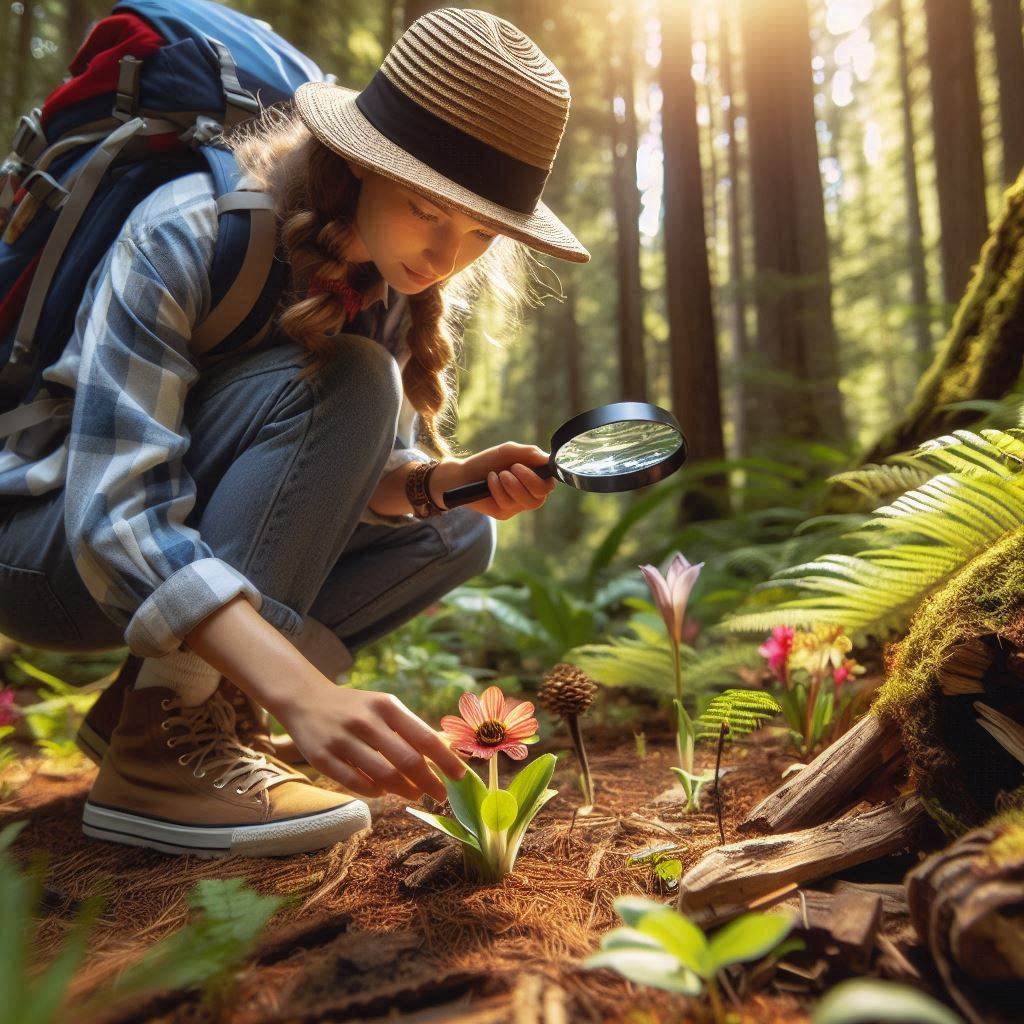Introduction
Overview of What a Botanist is
A botanist studies plants to understand their structure, growth, and interactions with the environment.
Their work plays a critical role in agriculture, medicine, environmental conservation, and biotechnology.
Botanists contribute to food security, discover new medicinal compounds, and help restore damaged ecosystems.
Importance of Botany in Various Fields
Botany impacts multiple fields, including:
- Agriculture: Developing pest-resistant crops and improving yields.
- Medicine: Identifying plants with therapeutic properties.
- Environmental Science: Preserving biodiversity and promoting reforestation.
Daily Responsibilities of a Botanist
A botanist’s day involves diverse tasks, depending on their area of specialization. Common activities include:
- Fieldwork: Collecting plant samples and observing ecosystems.
- Laboratory Work: Analyzing plant genetics or chemical properties.
- Data Recording: Documenting observations and experimental results.
- Report Writing: Publishing research findings and environmental assessments.
- Consultation: Collaborating with farmers, conservationists, or policymakers.
Botanists also monitor plant health and study how environmental changes impact vegetation.
Their findings often guide environmental policies and sustainable practices.
Whether in a lab or the field, botanists play a vital role in understanding and preserving the plant life that supports ecosystems and human well-being.
Education and Training
Educational Requirements to Become a Botanist
Becoming a botanist requires a solid educational foundation in plant sciences.
Most aspiring botanists start by earning a bachelor’s degree in botany, biology, or a related field.
These degrees provide essential knowledge about plant biology, ecology, and taxonomy.
Coursework in botany typically includes plant anatomy, physiology, genetics, and ecology.
These subjects equip students with a deep understanding of plant life and how plants interact with their environment.
A bachelor‘s degree alone can open entry-level positions in botany.
However, advanced research roles often require further education.
Many botanists pursue a master’s degree or a PhD to specialize in specific plant-related fields.
Graduate programs allow botanists to conduct detailed research and gain expertise in areas such as plant genetics, environmental conservation, or agricultural sciences.
A PhD is essential for those aiming to teach botany at a university or lead independent research projects.
The Importance of Hands-On Training and Experience in the Field
Hands-on training plays a critical role in a botanist‘s education.
Classroom learning provides theoretical knowledge, but practical experience solidifies this understanding.
Fieldwork is an integral part of most botany programs.
Students often participate in outdoor research projects, studying plants in their natural habitats.
Fieldwork helps them develop key skills in plant identification, data collection, and environmental observation.
These experiences prepare botanists to tackle real-world challenges in ecosystems and agriculture.
Internships and volunteer work are excellent ways for budding botanists to gain field experience.
Many students intern at botanical gardens, research institutions, or environmental organizations.
These experiences allow them to apply classroom knowledge in a professional setting, learning from experienced botanists.
Volunteering for conservation projects or participating in ecological surveys can also help students build essential skills and expand their professional network.
Any Specific Degrees or Certifications Needed
Beyond formal education, certifications can boost a botanist‘s career prospects.
While not always required, certifications in specialized areas can be highly valuable.
For example, some botanists earn certification in plant taxonomy, which confirms their expertise in classifying plant species.
Certification from organizations like the Ecological Society of America or the Society for Conservation Biology can also enhance a botanist’s qualifications.
These certifications demonstrate a commitment to staying current in the field and can improve job opportunities.
In short, aspiring botanists must complete a bachelor’s degree, with many advancing to graduate studies for specialized roles.
Hands-on experience through internships, fieldwork, and volunteering is crucial.
Additionally, certifications in specific plant science areas can further enhance a botanist‘s qualifications and career potential.
Conducting Research in Botany
How botanists conduct research in various areas
Botanists play a crucial role in advancing our understanding of plants.
One of their key responsibilities is conducting research.
Through research, botanists explore various areas of plant science, such as plant taxonomy, ecology, and biodiversity.
Plant taxonomy involves classifying and identifying plants, which helps organize the vast diversity of plant species.
Research in ecology focuses on how plants interact with their environments, providing insights into ecosystems and how they function.
Biodiversity studies allow botanists to understand the variety of plant species and their importance in maintaining healthy ecosystems.
The tools and techniques used in botanical research
In their research, botanists use a wide range of tools and techniques.
Fieldwork is essential for collecting plant samples in natural habitats.
Botanists often carry tools such as plant presses, hand lenses, and soil sampling kits.
These tools help them gather important data directly from the environment.
In addition, botanists use laboratory equipment like microscopes, DNA sequencing machines, and computers to analyze the samples.
Advances in technology have revolutionized botanical research by allowing more precise analysis of plant structures, genetics, and growth patterns.
Botanical research also relies on various methodologies.
Controlled experiments help botanists test hypotheses about plant growth, reproduction, and responses to environmental factors.
For example, they may examine how plants respond to changes in temperature, light, or water availability.
Data analysis is another essential aspect, where botanists use statistical tools and software to interpret their findings.
Geographic Information Systems (GIS) help botanists map plant distributions and analyze spatial data, enabling them to study plant populations across different regions.
The importance of research in advancing botany as a science
The importance of research in botany cannot be overstated.
Research advances our understanding of plant biology and enables botanists to make critical contributions to fields like agriculture, conservation, and climate science.
By studying plant taxonomy, botanists can help conserve endangered species and maintain biodiversity.
Ecological research informs conservation efforts by identifying plant species that are critical to ecosystems.
Research on biodiversity also highlights the importance of protecting diverse plant species, which serve as the foundation of many ecosystems and human livelihoods.
Botanical research has broader applications that impact various industries and fields.
In agriculture, botanists‘ research helps improve crop yields, develop disease-resistant plants, and enhance sustainable farming practices.
In medicine, many plant species are studied for their potential medicinal properties, leading to the development of new drugs.
Research on plants‘ role in climate regulation helps scientists understand how vegetation affects the Earth‘s carbon cycle and climate patterns.
Basically, botanical research is vital for advancing science and addressing global challenges.
The tools, techniques, and knowledge gained through research allow botanists to contribute to a healthier, more sustainable planet.
Read: The Impact of Technology on the Chemist Profession in the US
Collecting and Analyzing Plant Samples
The Process of Collecting Plant Samples in the Field
Botanists play a crucial role in studying plant life by collecting and analyzing plant samples.
The process starts in the field, where botanists explore diverse environments to gather plant specimens.
Botanists choose locations based on research objectives, aiming to find specific plant species or observe environmental changes.
They document the habitat conditions, soil quality, and climate factors before collecting samples.
Using specialized tools like plant presses, botanists carefully preserve the specimens to prevent damage during transportation.
How Botanists Analyze These Samples in a Lab Setting
Once in the lab, botanists analyze the collected samples through various scientific methods.
They examine the plant’s physical structure, including leaves, roots, and stems, to identify key traits.
Advanced microscopes allow them to study the cellular makeup of plants, identifying genetic variations or signs of disease.
Botanists may also use chemical analysis to detect nutrients, toxins, or other compounds within the plant.
DNA sequencing is another powerful tool, helping botanists understand a plant’s genetic makeup and evolutionary history.
The Importance of Accurate Data Collection and Analysis for Plant Research
Accurate data collection and analysis are critical for successful plant research.
Field data, such as location, temperature, and soil composition, provide valuable context for lab findings.
Without proper documentation, researchers may overlook important environmental factors influencing plant growth.
In the lab, careful analysis helps ensure that conclusions drawn from the samples are valid.
Any mistake in data recording can lead to incorrect conclusions, hindering further research.
Plant samples offer botanists vital information about biodiversity, plant health, and environmental changes.
The insights gained from these samples can inform conservation efforts, agricultural development, and ecological restoration projects.
In agricultural research, botanists analyze plants to improve crop yields, enhance resistance to pests, and develop more sustainable farming practices.
In conservation, they help identify endangered species and study their habitats to protect them from extinction.
Analyzing plant samples is also essential for understanding how plants respond to environmental stressors like climate change.
Botanists can track changes in plant populations over time, identifying patterns that signal shifts in ecosystems.
By studying plant adaptations, botanists contribute to the development of solutions to environmental challenges, such as restoring damaged ecosystems or creating climate-resilient crops.
Overall, collecting and analyzing plant samples allows botanists to unlock the secrets of plant life.
Their work drives advances in agriculture, conservation, and environmental science.
Precise data collection and thorough lab analysis are essential for producing accurate results, leading to better understanding and more effective solutions for global plant-related challenges.
The meticulous efforts of botanists ensure that we continue to learn from the world‘s plant life, preserving ecosystems and improving human well-being.
Read: US Chemistry Conferences and Symposiums to Attend in 2024
Identifying Plant Species
The Role of Botanists in Identifying and Classifying Plant Species
Botanists play a critical role in identifying and classifying plant species.
They study plants, both common and rare, to understand their characteristics, origins, and relationships with other species.
Accurate identification allows botanists to categorize plants systematically and contribute to scientific knowledge.
Transform Your Career Today
Unlock a personalized career strategy that drives real results. Get tailored advice and a roadmap designed just for you.
Start NowHow Botanists Use Taxonomic Keys and Other Tools to Identify Plants
Botanists use various tools to identify plant species accurately.
A key tool is the taxonomic key, a step-by-step guide that helps botanists differentiate plants based on specific characteristics.
These keys allow botanists to compare plants by features such as leaf shape, flower structure, or stem texture.
Taxonomic keys help botanists narrow down the possibilities to correctly classify plants into their respective species, genera, or families.
Other tools assist botanists in their identification work.
Microscopes, for instance, are crucial for examining minute plant parts such as pollen grains or cell structures.
DNA analysis has also become an important modern tool, enabling botanists to identify plants by their genetic code.
This method is particularly helpful when traditional identification methods are inconclusive.
Combining these tools ensures botanists can confidently identify and classify plant species.
The Importance of Accurate Plant Identification for Conservation Efforts
Accurate plant identification is vital for several reasons.
First, it ensures scientists can differentiate between native and invasive species.
Invasive species often disrupt ecosystems, so correctly identifying them allows conservationists to take action to protect native plants.
Moreover, identifying endangered species helps prioritize conservation efforts.
Botanists often work with conservationists to track the populations of rare or threatened plants and develop strategies to preserve them.
Without proper identification, these conservation efforts would be less effective.
Additionally, plant identification contributes to understanding biodiversity.
By classifying plants, botanists help build a clearer picture of the variety of life in a given ecosystem.
This understanding is essential for maintaining healthy ecosystems and addressing issues like habitat loss, pollution, or climate change.
The work botanists do in identifying and classifying plant species is fundamental to scientific research and conservation.
Using taxonomic keys and modern tools, they ensure plants are accurately identified and categorized.
This work supports vital conservation efforts by helping protect endangered species, combat invasive plants, and maintain biodiversity.
Accurate plant identification serves as the foundation for preserving ecosystems and ensuring a sustainable future for plants and the environment they support.
Read: Key Roles and Responsibilities of a Chemist in the US

Conservation and Sustainability
Botanists play a crucial role in conservation efforts by studying endangered plant species.
Their research helps identify plants at risk of extinction and develop strategies to protect them.
By understanding plant biology, botanists work to restore threatened habitats and preserve biodiversity.
How Botanists Contribute to Conservation Efforts by Studying Endangered Plant Species
Botanists assess the health of ecosystems and monitor changes in plant populations.
These findings guide conservation programs, influencing policies to safeguard native species.
Their efforts ensure that endangered plants receive the protection needed to survive and thrive in their natural habitats.
The Role of Botanists in Promoting Sustainable Practices in Agriculture and Forestry
In agriculture and forestry, botanists promote sustainable practices that balance resource use and environmental preservation.
They study crop species to enhance productivity while minimizing environmental damage.
Botanists also develop methods to reduce the use of harmful chemicals, like pesticides and fertilizers, by encouraging natural plant defenses.
In forestry, botanists collaborate with land managers to maintain healthy forests.
They analyze tree growth patterns and recommend sustainable harvesting practices.
These efforts support forest regeneration and help prevent deforestation, ensuring long-term environmental stability.
Sustainable agriculture benefits greatly from the work of botanists.
By studying plant genetics and soil health, botanists help farmers optimize crop yields while conserving water and nutrients.
They also research methods to improve the resilience of crops to pests and diseases, reducing the need for chemical interventions.
The Importance of Botany in Addressing Environmental Challenges Such as Climate Change
Botanists are essential in addressing environmental challenges like climate change.
They study how plants respond to changing climate conditions, such as temperature increases and altered rainfall patterns.
This research helps scientists predict how ecosystems will shift and what actions are needed to mitigate damage.
Botanists also explore the role of plants in carbon sequestration, a process critical to reducing greenhouse gases.
By understanding which plant species store the most carbon, botanists provide valuable insights into reforestation and land management strategies that can slow climate change.
Conservation projects often rely on botanists to restore ecosystems damaged by human activity.
Botanists identify native species that can thrive in degraded environments, aiding in reforestation and habitat restoration efforts.
These initiatives not only improve biodiversity but also support sustainable land use practices that benefit local communities.
As environmental issues grow more pressing, the work of botanists becomes increasingly important.
Their expertise in plant biology, conservation, and sustainability equips them to tackle complex ecological challenges.
Whether protecting endangered species, promoting sustainable agriculture, or addressing climate change, botanists are key players in ensuring a healthier planet for future generations.
In fact, botanists contribute significantly to conservation and sustainability.
Their research and practical applications protect ecosystems, promote sustainable practices, and address global environmental challenges like climate change.
Read: Earning Potential: Chemist Salaries Across US States
Teaching and Outreach
Botanists play a vital role in educating the public about plant science.
They engage in outreach programs to share their knowledge.
These programs aim to increase awareness of plant biology, ecology, and conservation.
By using hands-on activities, they make learning fun and accessible.
How botanists educate the public about plant science through outreach programs and public speaking engagements
Many botanists give public speaking engagements at schools and community events.
They explain complex botanical concepts in simple terms.
This approach helps spark interest in plant science among diverse audiences.
Botanists often partner with educational institutions to develop workshops and seminars.
These sessions focus on topics like plant identification and environmental sustainability.
The role of botanists in mentoring aspiring scientists and students
Mentoring aspiring scientists is another essential responsibility of botanists.
They guide students pursuing careers in plant sciences.
This mentorship can happen in various forms, such as one-on-one meetings or internships.
Botanists share valuable insights about academic paths and research opportunities.
Their support encourages students to explore their interests and develop critical thinking skills.
Botanists often work closely with university students during research projects.
They help students design experiments and analyze data.
This hands-on experience is crucial for students‘ professional development.
By providing guidance, botanists instill confidence in future scientists.
This mentorship creates a pipeline of knowledgeable individuals who can advance botanical research.
The importance of science communication in promoting botanical knowledge
Science communication plays a significant role in promoting botanical knowledge.
Effective communication ensures that scientific findings reach a broader audience.
Botanists strive to convey the importance of plants in our daily lives.
They highlight how plants contribute to food security, medicine, and environmental health.
By sharing this information, they raise awareness about the need for plant conservation.
Many botanists also engage with media outlets to share their expertise.
They write articles, participate in interviews, and contribute to documentaries.
These efforts broaden the public‘s understanding of plant science.
They help demystify complex concepts and make them relatable.
By engaging with the media, botanists reach diverse audiences.
Additionally, botanists develop educational materials for schools and community groups.
They create brochures, videos, and interactive websites to engage learners.
These resources enhance public understanding of plant biology.
They also promote awareness of local flora and conservation efforts.
Overall, teaching and outreach are crucial aspects of a botanist’s role.
They educate the public through programs and speaking engagements.
Mentoring aspiring scientists is equally important for nurturing future talent.
Through effective science communication, botanists promote knowledge and appreciation of plant sciences.
Their efforts inspire individuals to value the vital role plants play in our lives and the environment.
By engaging with the community, they foster a deeper connection between people and the plant world.
Collaboration with Other Scientists
How botanists collaborate with other scientists
Botanists play a vital role in the broader scientific community.
Their work often overlaps with that of other scientists, such as ecologists, geneticists, and environmental scientists.
This collaboration enhances research and fosters innovation across disciplines.
Interdisciplinary Nature of Botany
The field of botany is inherently interdisciplinary.
Botanists study plant life, but their research often connects to various scientific areas.
For instance, ecologists examine ecosystems and how plants interact within them.
By working together, botanists and ecologists can understand the impact of plants on environmental health.
Geneticists also collaborate with botanists.
They explore the genetic makeup of plants, studying traits that contribute to growth, resilience, and reproduction.
This partnership allows for advancements in plant breeding and genetic engineering, leading to improved crop varieties.
Environmental scientists frequently join forces with botanists to address pressing ecological issues.
These scientists analyze how plants affect soil quality, water resources, and climate change.
Collaborations can lead to innovative solutions for sustainability and environmental conservation.
Importance of Collaboration
Collaboration is crucial for advancing scientific knowledge.
By working together, scientists can share insights and methodologies.
This exchange of ideas fosters a deeper understanding of complex biological systems.
Moreover, interdisciplinary collaborations can tackle global challenges.
For example, the increasing impact of climate change on plant life requires diverse expertise.
Botanists and environmental scientists can study climate effects on vegetation patterns.
Their combined efforts can inform conservation strategies and policy recommendations.
Additionally, collaborations can enhance educational opportunities.
Joint research projects allow students and early-career scientists to gain valuable experience.
They learn to approach problems from multiple perspectives, fostering critical thinking skills.
Field studies often require teamwork among various scientific disciplines.
When studying plant communities, scientists may monitor interactions between species.
Botanists can collect data on plant health while ecologists observe animal behaviors.
This comprehensive approach leads to a richer understanding of ecological dynamics.
In laboratory settings, collaborative research can accelerate discoveries.
Shared resources, such as advanced technology and equipment, enhance experimental capabilities.
Scientists can conduct more complex analyses, leading to significant breakthroughs.
Furthermore, scientific publications often arise from collaborative efforts.
When scientists publish joint research, it enhances credibility and impact.
Collaborative studies frequently receive more attention in academic circles, leading to increased funding opportunities.
Most importantly, collaboration is essential in the field of botany.
By working with ecologists, geneticists, and environmental scientists, botanists can enhance research and address complex challenges.
The interdisciplinary nature of botany enriches scientific knowledge and promotes innovative solutions.
Through teamwork, scientists can make significant advancements that benefit society and the environment.
You Might Also Like: Biomedical Engineering: Developing Wearable Technology
Conclusion
Botanists play a crucial role in studying plant life.
Their daily responsibilities include researching, collecting, and analyzing plant specimens.
They often conduct field studies to observe plants in their natural habitats.
By identifying and classifying different species, they contribute valuable information to the scientific community.
In the lab, botanists perform experiments and analyze data related to plant growth and development.
They also study plant diseases and work on solutions to combat these threats.
Through collaboration with other scientists, they share insights on the impact of environmental changes on plant health.
Botanists contribute significantly to conservation efforts.
By understanding plant ecology, they help protect endangered species and restore habitats.
Their work informs sustainable practices that benefit ecosystems and biodiversity.
By conserving plant life, they ensure that future generations can enjoy the natural world.
Moreover, botany is essential for agriculture and food production.
Botanists research crop improvement and sustainable farming practices.
They develop methods to enhance yields and resist pests, which is vital for food security.
Their expertise helps farmers adapt to climate change and environmental challenges.
In addition, botanists contribute to the pharmaceutical industry.
Many medicines originate from plant compounds.
Botanists study these plants to discover new drugs and treatments.
Their research leads to breakthroughs that improve human health and wellbeing.
[E-Books for Sale]
The Big Book of 500 High-Paying Jobs in America: Unlock Your Earning Potential
$19.99 • 500 High-Paying Jobs • 330 pages
Explore 500 high-paying jobs in America and learn how to boost your career, earn more, and achieve success!
See All 500 High-Paying Jobs of this E-Book
1001 Professions Without a Degree: High-Paying American Jobs You Can Start Now
$19.99 • 1001 Professions Without a Degree • 174 pages
Discover 1001 high-paying jobs without a degree! Unlock career tips, skills, and success strategies for just $19.99!




